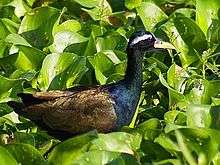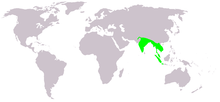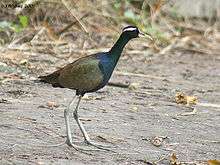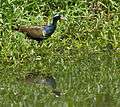Bronze-winged jacana
| Bronze-winged jacana | |
|---|---|
 | |
| Scientific classification | |
| Kingdom: | Animalia |
| Phylum: | Chordata |
| Class: | Aves |
| Order: | Charadriiformes |
| Family: | Jacanidae |
| Genus: | Metopidius Wagler, 1832 |
| Species: | M. indicus |
| Binomial name | |
| Metopidius indicus (Latham, 1790) | |
 | |

The bronze-winged jacana (Metopidius indicus) is a jacana. It is the only member of the genus Metopidius. The jacanas are a group of waders in the family Charadriidae, which are identifiable by their huge feet and claws which enable them to walk on floating vegetation in the shallow lakes that are their preferred habitat. They are found worldwide within the tropical zone. For the origin and pronunciation of the name, see Jacana.
The bronze-winged jacana breeds in India and southeast Asia. It is sedentary apart from seasonal dispersion. It lays four black-marked brown eggs in a floating nest. The males, as in some other wader families like the phalaropes, take responsibility for incubation.
_I_IMG_7760.jpg)
These are conspicuous and unmistakable birds. They are 29 cm (11 in) long, but the females are larger than the males. They are mainly black, although the inner wings are very dark brown and the tail is red. There is a striking white eyestripe. The yellow bill extends up as a red coot-like frontal shield, and the legs and very long toes are grey.
Young birds have brown upperparts. Their underparts are white, with a buff foreneck.
The bronze-winged jacana's feeds on insects and other invertebrates picked from the floating vegetation or the water's surface.
Call is a wheezy piping seek-seek-seek given mostly in alarm.
_I_IMG_9190.jpg)
When forced they sometimes choose to hide by submerging themselves. The male may carry chicks between the wings and body.
Measurements (from Rasmussen and Anderton, 2005) Length 280–310 mm
Wing 150–197 mm (males 150-180mm, females 167–187 mm)
Bill from tip to top of frontal shield 34–46 mm (adults) 32-38 (juveniles)
Tarsus 61–76 mm
Tail 40–52 mm
Mating System
Bronze-winged jacanas have a territorial, sex-role reversed system. They are polyandrous, and the females are larger and more brightly colored than their male counterparts. The females compete with each other for harems of males to incubate their clutches of eggs. Each female’s territory encompasses one to four males and their individual territories. The density of breeding territories can be limited by habitat availability and the territorial competition with other females and their harems. Although there is no clear evidence for a relationship between male territory size and the distribution of available resources, heavier males have been shown to defend their territories from other males. The overall distribution of territories appears to be small areas controlled by individual males, with the harems of females encompassing one or more of the male territories. Even though the territory size of females is positively correlated with the size of their harems, it does not seem to be related to the overall quality of the habitat. Females could attempt to maximize harem size by including as many male territories as they can, while males in larger harems would have to defend smaller territories. As a result, the degree of polyandry of the Bronze-winged jacana is dependent on the territory sizes of males and females.
The breeding system of the bronze-winged jacana leads to intense sperm competition, as female jacanas copulate with multiple males prior to laying their clutch. Before laying the clutch, the female would spend more time with the specific male that would receive the clutch (called the “receiver”). Studies have also shown that receivers gain more copulations than non-receivers. Since the receivers provide all of the parental care, females should, in theory, comply with male demands for copulations to convince them of their paternity, so they will care for the clutch. Receivers have been observed to destroy clutches in which they only had a low share of the paternity. Although females offer copulations to non-receiver males in order to maintain their presence in her harem, these copulations are less important than copulations to assure the receivers of their paternity. The cost of clutches being destroyed by receivers is much higher than losing males from her harem.
Since the males have no individual control over the maximum number of their copulations, the males in polyandrous harems vie for the female’s attention through a call, called a “yell,” to attract her and gain sexual access. It has been shown that male jacanas in larger harems yelled at higher rates during the periods of time when all copulations took place, while males that already received their clutch or were involved in chick care yelled at lower and rates. These yells attracted the female bronze-winged Jacana when she is far from the yeller. A study showed that females seem to use yells to assess male quality, as the males that yelled at the highest rates were able to receive the greatest number of copulations.[2] Females may also respond to the yells of males in their territory since they could attract other females who could intrude on their territory.
References
- ↑ BirdLife International (2012). "Metopidius indicus". IUCN Red List of Threatened Species. Version 2013.2. International Union for Conservation of Nature. Retrieved 26 November 2013.
- ↑ Butchart, S.H.M., Seddon, N. & Ekstrom, J.M.M. (1999) Yelling for sex: harem males compete for female access in bronze-winged jacanas. Animal Behavior.
- Hayman, Peter; John Marchant; A J Prater (1988). Shorebirds. Helm. ISBN 0-7470-1403-5.
- Rasmussen, Pamela C; John C Anderton (2005). Birds of South Asia : the Ripley guide. Washington, D.C.: Smithsonian Institution. ISBN 84-87334-67-9. Also published by Lynx Edicions in Barcelona. Other ISBNs are: ISBN 84-87334-65-2 and ISBN 84-87334-66-0.
- Butchart, S.H.M., Seddon, N. & Ekstrom, J.M.M. (1999) Polyandry and competition for territories in bronze-winged jacanas. Animal Ecology.
- Butchart, S.H.M. (1998) Sexual conflicts and polyandry in bronze-winged jacanas. PhD Thesis, University of Cambridge, Cambridge.
- Butchart, S.H.M. Sexual conflicts and copulation patterns in polyandrous bronze-winged jacanas (Metopidius indicus). Behavior.
- Emlen, S.T., Wrege, P.H. (2004) Size dimorphism, intrasexual competition and sexual selection in wattled jacana Jacana jacana, a sex-role-reversed shorebird in Panama. Auk.
See also Ciconiiformes, as the influential Sibley-Ahlquist taxonomy considers the Jacana to be in this order
Gallery
-
_juveniles_W_IMG_6688.jpg)
juveniles in Krishna Wildlife Sanctuary, Andhra Pradesh, India.
-
_juveniles_W_IMG_6687.jpg)
juveniles in Krishna Wildlife Sanctuary, Andhra Pradesh, India.
-
_in_a_Lotus_Pond_in_Kolkata_I_IMG_7504.jpg)
In a Lotus Pond in Kolkata, West Bengal, India.
-

In Kolkata, West Bengal, India.
-
_with_juveniles_I2_IMG_2572.jpg)
Adult with juveniles in Kolkata, West Bengal, India.
-

In Kolkata, West Bengal, India.
-
_I-_Kolkata_IMG_5437.jpg)
Immature in Kolkata, West Bengal, India.
-
_in_AP_W_IMG_3489.jpg)
in Uppalapadu, Andhra Pradesh, India.
-
_in_AP_W_IMG_3480.jpg)
in Uppalapadu, Andhra Pradesh, India.

_at_Bharatpur_IMG_8547.jpg)
_at_Bharatpur_Im_IMG_8551.jpg)